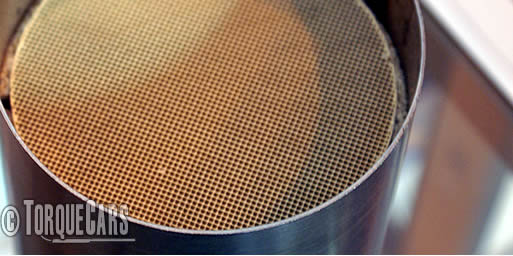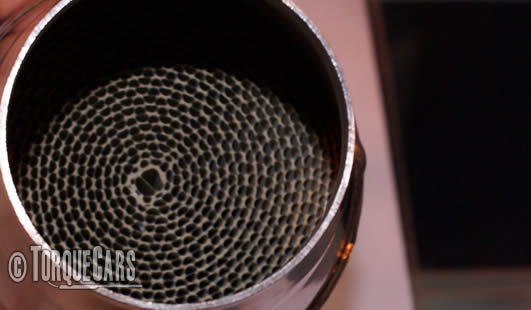Catalysts - how do they work and what do they do?
"We reveal all about Catalysts in Car exhausts."

What is a catalyst and what does it do?
Some mistake the catalyst for a filter, it is clearly not. It merley causes a reaction in the exhaust gases that turn harmful emissions into more friendly ones.
In an ideal world a car engine would efficiently burn all the petrol supplied to the engine and emit nothing but carbon dioxide and water vapour.
Sadly, the internal combustion engine is not a very efficient beast, as a result several different pollutants are emitted in the exhaust gases.
Catalytic converters were made mandatory in the UK for all new cars from 1st January 1993 in order to reduce pollution. They are frequently blamed for a loss of power which is something we address in our sports catalyst article.
What are the harmful components in exhaust fumes?
The incomplete combustion of the petrol gives rise to carbon monoxide and various Volatile Organic Compounds (VOCs). This problem is worst when idling or decelerating. Carbon monoxide is poisonous and a greenhouse gas. Volatile Organic Compounds are harmful to health and some are linked to cancer.
The very high temperatures in the engine (over 1500°C) causes nitrogen from the air to react with the oxygen from the air to form nitrous oxides. These cause various problems, nitrogen dioxide for example reacts with the water in the atmosphere to form dilute nitric acid which gives rise to acid rain.
The action of sunlight on this mix of pollutants gives rise to photochemical smogs and the formation of other pollutants such as ozone.
So how does the catalyst convert these elements?
You can think of your catalytic converter as a dating agency for exhaust pollutants, helping them meet their ideal partner and converting them to carbon dioxide and water vapour. Some of the chemical reactions that take place in the catalytic converter are shown below.
carbon monoxide + oxygen → carbon dioxide
Volatile Organic Compounds (partly burnt petrol) + oxygen → carbon dioxide + water
nitrogen monoxide + carbon monoxide → carbon dioxide + nitrogen

Above a standard Catalyst cross section and below a performance sports catalyst. You can see the sports cat flows much better and is less restrictive. Various grades of cell size are available between these two extremes.

The catalytic converter is a marvel of engineering design. When you turn on your engine it needs to cope with a rapid temperature rise of several hundred °C in less than a minute. Operating temperatures are up to 1000°C, on a highly tuned TorqueCars members engine this becomes more frequently at the upper end of this range.
The catalyst needs to make good contact with the exhaust gases without impeding its flow. The speed at which the exhaust gases flow means the catalyst has a matter of milliseconds to work its magic.
The answer is a ceramic lattice with around 400 channels per square inch coated with a mixture containing the precious metals platinum, rhodium and palladium as well as other metal oxides.
One of the main causes of damage to catalytic converters is high temperatures. The usual operating temperature is 150-600°C, but misfiring and high driving speeds can lead to temperatures of up to 1000°C. This damages the surface of the catalyst reducing its efficiency and in extreme circumstances can melt the ceramic.
Another problem is poisoning due to contaminants in the exhaust gases. Sulphur in the petrol or phosphorous from engine oil can both permanently damage the effectiveness of the catalyst.
Please join us in our friendly forum to catch up with the latest trends in catalysts and exhaust systems for your car.
Please Check out my YouTube channel, we're regularly adding new content...
PLEASE HELP: I NEED YOUR DONATIONS TO COVER THE COSTS OF RUNNING THIS SITE AND KEEP IT RUNNING. I do not charge you to access this website and it saves most TorqueCars readers $100's each year - but we are NON PROFIT and not even covering our costs. To keep us running PLEASE Donate here
If you liked this page please share it with your friends, drop a link to it in your favourite forum or use the bookmarking options to save it to your social media profile.
Feedback - What do You Think?
Please use our forums if you wish to ask a tuning question, and please note we do not sell parts or services, we are just an online magazine.
Help us improve, leave a suggestion or tip
Please watch this video and subscribe to my YouTube channel.

 Click to accept YouTube Cookies & Play.
Click to accept YouTube Cookies & Play.